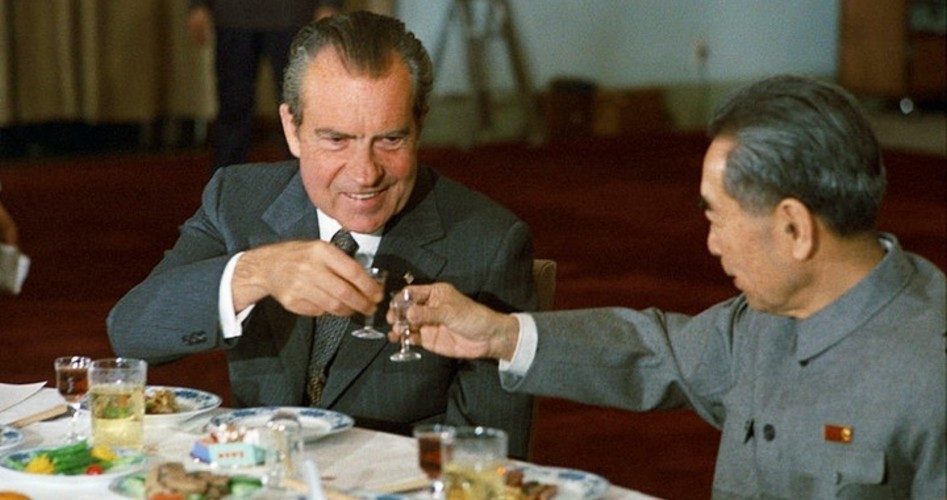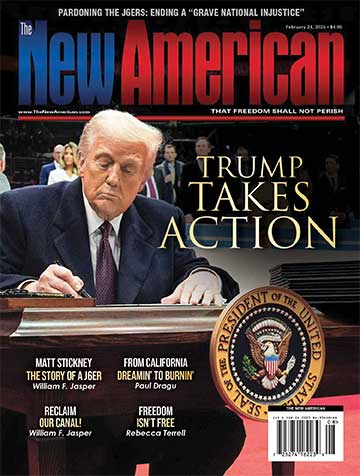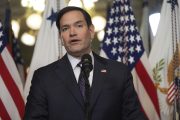
President Barack Obama politely declined the title of “most liberal president in U.S. history” when asked by Fox News commentator Bill O’Reilly if that is what he is. Obama magnanimously passed that honor off to another president, who was unable to refuse it, being dead now for the past 20 years.
“You know, the truth of the matter is, is that when you look at some of my policies, in a lot of ways, Richard Nixon was more — more liberal than I was,” Obama said during the interview, shown live in its first 10 minutes before the Super Bowl Sunday and recorded for broadcast in its entirety Monday night on The O’Reilly Factor.
Obama credited Nixon (shown on left) with creating the Environmental Protection Agency and “a whole lot of the regulatory state that has helped make our air and water clean.” O’Reilly expressed surprise at the choice of the Republican Nixon for a comparison. “I thought you were gonna say FDR,” he said.
“Well, FDR — Johnson,” Obama replied. “But I tend not to think about these things in terms of liberal and Democrat — or liberal and conservative, because at any given time the question is what does the country need right now? And what — right now what the country needs is, roads, bridges, infrastructure. We got two trillion dollars worth of unmet needs. We could put — be putting construction workers back to work right now, folks that you like to champion,” he told O’Reilly. “Why aren’t we doing it? That’s not a liberal or conservative agenda.”
The “liberal” and “conservative” labels do get a bit murky when Barack Obama, who came to the White House as the darling of those recycled, re-branded liberals known as “progressives,” admits to being surpassed in liberalism by Richard Milhous Nixon, the object of liberal wrath throughout his long political career. Conservatives, for the most part, supported the Nixon presidency, despite strong objections from the Right over his imposition of the nation’s only peacetime wage-and-price controls, the devaluing of the dollar, his fawning tributes to the communist tyrant Mao Tse-tung during his visit to China, his proposal for a guaranteed annual income (called the Family Assistance Plan), and other programs and policies of the Nixon presidency (1969-74) that most conservatives considered anathema. As Fox News commentator Douglas Schoen wrote last year on the 100th anniversary of Nixon’s birth, the 37th president was “a pro-big government, pro-public spending, and pro-social safety net president.”
Excessive government regulation was something Nixon and the “conservatives” in his administration opposed in principle and embraced in practice. “Probably more new regulation was imposed on the economy during the Nixon administration than in any other presidency since the New Deal,” said Herbert Stein, who was chief economic advisor during the Nixon administration.
Obama, who is openly fond of bypassing Congress to achieve legislative ends through executive orders, might admire the way Nixon established the Environmental Protection Agency by executive order in July 1970 — though it was ratified by Congress later that year. Nixon also gave the nation Affirmative Action hiring quotas (called “goals”) and threw off the old conservative inhibitions about deficit spending. He embraced instead the pump-priming theories of British economist and liberal icon John Maynard Keynes, who urged governments to spend their way out of recessions and into prosperity. “I am now a Keynesian in economics,” Nixon announced in a 1971 TV interview. The prosperity that was supposed to follow Nixon’s “full employment” budgets got lost somewhere among the rising deficits, inflation, and economic stagnation that prevailed through the latter half of the 1970s.
Obama might have brought up another point of comparison between himself and Nixon that today’s Republicans might rather forget. Had Congress enacted a certain presidential proposal of 1974, America might now be in the 41st year of NixonCare — or the Milhous Medicine Plan.
“I shall propose a sweeping new program that will assure comprehensive health insurance protection to millions of Americans who cannot now obtain it or afford it, with vastly improved protection against catastrophic illnesses,” Nixon said in what would be his final State of the Union address.
“Nixon’s proposed reform would have required employers to buy health insurance for their employees and subsidize those who couldn’t afford it,” wrote Schoen. “Nixon’s version of national health care was a far more liberal concept than Bill Clinton’s or Barack Obama’s — and it failed because of Democratic opposition, not lack of support from Nixon’s own party.”
Nixon followed John F. Kennedy and Lyndon Johnson into the White House, having campaigned on promises to halt the growth of the federal government, balance the budget, and appoint judges who would be “strict constructionists” of the Constitution. Instead, the actions carried out and policies pursued by Nixon and his fellow Republicans inspired liberal economist John Kenneth Galbraith to publish a book near the end of Nixon’s first term entitled Who Needs the Democrats.
As it happened, Congress in 1974 had more pressing matters than Nixon’s health care plan to deal with — such as impeaching Nixon, for example. Nixon avoided that fate only by resigning just before the articles of impeachment would have come to a vote. Along with obstruction of justice during the investigation of the Watergate break-in, Nixon’s impeachable offenses included warrantless surveillance of his political adversaries, waging an unauthorized war in Cambodia, and attempting to use the IRS to harass and bedevil his enemies. Obama has backed the NSA’s collection of everyone’s telephone records and e-mail messages, and he waged an unauthorized war in Libya. Under Obama, the IRS launched investigations into the tax status of Tea Party and other conservative groups. He has outdone Nixon’s “enemies list” with a “kill list” of suspected terrorists, including U.S. citizens, who may be dispatched by drone attack, far from any battlefield and without any semblance of a trial.
When Nixon ran for president in 1968, he tried to overcome the old “Tricky Dick” persona with a more statesmanlike image of “the new Nixon.” The old “new Nixon” died in 1994, but there appears to be another model in the White House now. Perhaps Obama was being too modest in his interview with O’Reilly. He might be even more “Nixonian” than Nixon.
Photo of Richard Nixon and Chinese Premier Zhou Enlai



